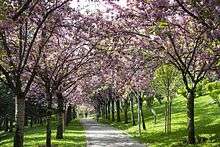Cherry blossom


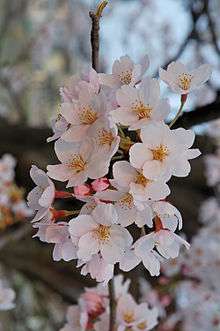
%E3%81%A8%E8%8A%9D%E6%A1%9C(%E3%81%97%E3%81%B0%E3%81%96%E3%81%8F%E3%82%89).jpg)
A cherry blossom is the flower of any of several trees of genus Prunus, particularly the Japanese cherry, Prunus serrulata, which is called sakura after the Japanese (桜 or 櫻; さくら).[1][2][3]
Cherry blossom is speculated to be native to the Himalayas.[4] Currently it is widely distributed, especially in the temperate zone of the Northern Hemisphere including Japan, China, Korea, Europe, West Siberia, India, Canada, and the United States.[5][6] Along with the chrysanthemum, the cherry blossom is considered the national flower of Japan.[7]
Many of the varieties that have been cultivated for ornamental use do not produce fruit. Edible cherries generally come from cultivars of the related species Prunus avium and Prunus cerasus. Cherry blossom are also closely related to other Prunus trees such as the almond, peach, plum and apricot and more distantly to apples, pears and roses.
Flower viewing
"Hanami" is the centuries-old practice of picnicking under a blooming sakura or ume tree. The custom is said to have started during the Nara Period (710–794) when it was ume blossoms that people admired in the beginning. But by the Heian Period (794–1185), cherry blossoms came to attract more attention and hanami was synonymous with sakura.[8] From then on, in both waka and haiku, "flowers" (花 hana) meant "cherry blossoms". The custom was originally limited to the elite of the Imperial Court, but soon spread to samurai society and, by the Edo period, to the common people as well. Tokugawa Yoshimune planted areas of cherry blossom trees to encourage this. Under the sakura trees, people had lunch and drank sake in cheerful feasts.
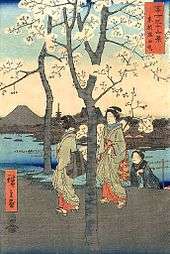
Every year the Japanese Meteorological Agency and the public track the sakura zensen (cherry blossom front) as it moves northward up the archipelago with the approach of warmer weather via nightly forecasts following the weather segment of news programs. The blossoming begins in Okinawa in January and typically reaches Kyoto and Tokyo at the end of March or the beginning of April. It proceeds into areas at the higher altitudes and northward, arriving in Hokkaidō a few weeks later. Japanese pay close attention to these forecasts and turn out in large numbers at parks, shrines, and temples with family and friends to hold flower-viewing parties. Hanami festivals celebrate the beauty of the cherry blossom and for many are a chance to relax and enjoy the beautiful view. The custom of hanami dates back many centuries in Japan. The eighth-century chronicle Nihon Shoki (日本書紀) records hanami festivals being held as early as the third century AD.
Most Japanese schools and public buildings have cherry blossom trees outside of them. Since the fiscal and school year both begin in April, in many parts of Honshū, the first day of work or school coincides with the cherry blossom season.
The Japan Cherry Blossom Association developed a list of Japan's Top 100 Cherry Blossom Spots[9] with at least one location in every prefecture.
Symbolism
In Japan, cherry blossoms symbolize clouds due to their nature of blooming en masse, besides being an enduring metaphor for the ephemeral nature of life,[10] an aspect of Japanese cultural tradition that is often associated with Buddhist influence,[11] and which is embodied in the concept of mono no aware.[12] The association of the cherry blossom with mono no aware dates back to 18th-century scholar Motoori Norinaga.[12] The transience of the blossoms, the exquisite beauty and volatility, has often been associated with mortality[10] and graceful and readily acceptance of destiny and karma; for this reason, cherry blossoms are richly symbolic, and have been utilized often in Japanese art, manga, anime, and film, as well as at musical performances for ambient effect. There is at least one popular folk song, originally meant for the shakuhachi (bamboo flute), titled "Sakura", and several pop songs. The flower is also represented on all manner of consumer goods in Japan, including kimono, stationery, and dishware.

The Sakurakai or Cherry Blossom Society was the name chosen by young officers within the Imperial Japanese Army in September 1930 for their secret society established with the goal of reorganizing the state along totalitarian militaristic lines, via a military coup d'état if necessary.[13]
During World War II, the cherry blossom was used to motivate the Japanese people, to stoke nationalism and militarism among the populace.[14] Even prior to the war, they were used in propaganda to inspire "Japanese spirit," as in the "Song of Young Japan," exulting in "warriors" who were "ready like the myriad cherry blossoms to scatter."[15] In 1932, Akiko Yosano's poetry urged Japanese soldiers to endure sufferings in China and compared the dead soldiers to cherry blossoms.[16] Arguments that the plans for the Battle of Leyte Gulf, involving all Japanese ships, would expose Japan to serious danger if they failed, were countered with the plea that the Navy be permitted to "bloom as flowers of death."[17] The last message of the forces on Peleliu was "Sakura, Sakura" — cherry blossoms.[18] Japanese pilots would paint them on the sides of their planes before embarking on a suicide mission, or even take branches of the trees with them on their missions.[14] A cherry blossom painted on the side of the bomber symbolized the intensity and ephemerality of life;[19] in this way, the aesthetic association was altered such that falling cherry petals came to represent the sacrifice of youth in suicide missions to honor the emperor.[14][20] The first kamikaze unit had a subunit called Yamazakura or wild cherry blossom.[20] The government even encouraged the people to believe that the souls of downed warriors were reincarnated in the blossoms.[14]
In its colonial enterprises, imperial Japan often planted cherry trees as a means of "claiming occupied territory as Japanese space".[14]
Cherry blossoms are a prevalent symbol in Irezumi, the traditional art of Japanese tattoos. In tattoo art, cherry blossoms are often combined with other classic Japanese symbols like koi fish, dragons or tigers.[21]
Varieties and blooming
The following species, hybrids, and varieties are used for sakura:[22][23][24][25][26]
- Prunus apetala var. pilosa
- Prunus campanulata
- Prunus ×furuseana
- Prunus incisa var. incisa
- Prunus incisa var. kinkiensis
- Prunus ×introrsa
- Prunus ×kanzakura
- Prunus ×miyoshii
- Prunus ×parvifolia
- Prunus pendula
- Prunus ×sacra
- Prunus sargentii
- Prunus serrulata
- Prunus ×sieboldii
- Prunus ×subhirtella
- Prunus ×syodoi
- Prunus ×tajimensis
- Prunus ×takenakae
- Prunus verecunda
- Prunus ×yedoensis

Japan has a wide variety of cherry blossoms (sakura); well over 200 cultivars can be found there.[27] The most popular variety of cherry blossom in Japan is the Somei Yoshino. Its flowers are nearly pure white, tinged with the palest pink, especially near the stem. They bloom and usually fall within a week, before the leaves come out. Therefore, the trees look nearly white from top to bottom. The variety takes its name from the village of Somei (now part of Toshima in Tokyo). It was developed in the mid- to late-19th century at the end of the Edo period and the beginning of the Meiji period. The Somei Yoshino is so widely associated with cherry blossoms that jidaigeki and other works of fiction often depict the variety in the Edo period or earlier; such depictions are anachronisms.
Winter sakura or fuyuzakura (Prunus subhirtella autumnalis) begins to bloom in the fall and continues blooming sporadically throughout the winter. It is said to be a cross between edohiganzakura, the Tokyo Higan cherry (P. incisa) and mamezakura (P. pendula).[28]
Other categories include yamazakura, yaezakura, and shidarezakura. The yaezakura have large flowers, thick with rich pink petals. The shidarezakura, or weeping cherry, has branches that fall like those of a weeping willow, bearing cascades of pink flowers.
By country
Australia
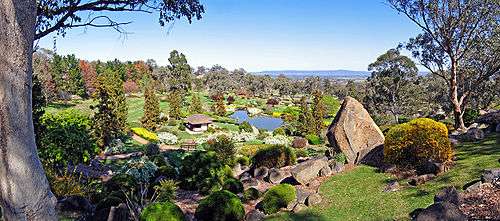
During World War II, a prisoner of war (POW) camp near the town of Cowra in New South Wales, Australia was the site of one of the largest prison escapes of the war, on 5 August 1944. During the Cowra breakout and subsequent rounding up of POWs, four Australian soldiers and 231 Japanese soldiers died and 108 prisoners were wounded. The Japanese War Cemetery holding the dead from the Breakout was tended to after WWII by members of the Cowra RSL and ceded to Japan in 1963. In 1971 the Cowra Tourism Development decided to celebrate this link to Japan, and proposed a Japanese garden for the town. The Japanese government agreed to support this development as a sign of thanks for the respectful treatment of their war dead; the development also received funding from the Australian government and private entities.
The garden was designed by Ken Nakajima (1914–2000), a world-renowned designer of Japanese gardens at the time. The first stage was opened in 1979, with a second stage opened in 1986.
The gardens were designed in the style of the Edo period and are a kaiyū-shiki or strolling garden. They are designed to show all of the landscape types of Japan. At five hectares (12 acres), the Cowra Japanese Garden is the largest Japanese garden in the Southern Hemisphere. An annual cherry blossom festival is a major event in Cowra's tourism calendar and is held in the gardens during September.
Brazil
With the Japanese diaspora to Brazil, many immigrants brought seedlings of cherry trees. In São Paulo State, home to the largest Japanese community outside Japan, it is common to find them in Japan-related facilities and in some homes, usually of the cultivars Prunus serrulata 'Yukiwari' and Prunus serrulata var. lannesiana 'Himalaya'. Some cities, as Garça[29] and Campos do Jordão,[30] have annual festivals to celebrate the blooming of the trees and the Japanese culture. In the Parana State (in southern Brazil), many cities received many of these immigrants, who planted the trees, as in Apucarana,[31] Maringá, Cascavel[32] and especially in the capital city of Curitiba.[33]
In the capital city of Parana, the first seedlings were brought by Japanese immigrants in the first half of the 20th century, but large quantities of them were only planted from the 1990s, with the opening of the Botanical Garden of Curitiba.[33] Nowadays the seedlings are produced locally and used in afforestation[34] of streets and squares – as in the Japanese Square, where there are more than 30 cherry trees around the square which were sent by the Japanese Empire to Curitiba.[35]
Canada

Vancouver, BC is famous for its thousands of cherry trees (estimated 50,000) lining many streets and in many parks, including Queen Elizabeth Park and Stanley Park. Vancouver holds the Vancouver Cherry Blossom Festival every year.[36] With multiple varieties and a temperate climate, they begin to bloom in February yearly and peak in April.
High Park in Toronto, Ontario features many Somei-Yoshino cherry trees (the earliest species to bloom and much loved by the Japanese for their fluffy white flowers) that were given to Toronto by Japan in 1959. Through the Sakura Project, the Japanese Consulate donated a further 34 cherry trees to High Park in 2001, plus cherry trees to various other locations like Exhibition Place, McMaster University, York University (near Calumet College and on Ottawa Road near McLaughlin College) and the University of Toronto's main (next to Robarts Library) and Scarborough campuses. Niagara Falls also has many near the Falls itself. Royal Botanical Gardens in Burlington and Hamilton was also the recipient of a number of Somei-Yoshino cherry trees that were donated by the Consulate-General of Japan in Toronto as part of the Sakura Project. The trees are located in the Arboretum and the Rock Garden and were planted to celebrate the continual strengthening of friendship between Japan and Canada. Peak bloom time at Royal Botanical Gardens is normally around the last week of April or the first week of May.

China
Cherry trees naturally grow in the middle northern or southern part of China, the area nearby the sea. However, the most famous cherry blossom parks in China reflect Japan's brief occupation of parts of China during the first half of the 20th century or the donation from Japan thereafter:
- Longwangtang Cherry Blossom Park in Lushun, Dalian, Liaoning
- East Lake Cherry Blossom Park near Wuhan University, in Donghu District, Wuhan, Hubei
- Wuhan University, in Donghu District, Wuhan, Hubei
- Nanshan Botanical Garden in Nan'an District, Chongqing
France
Parc de Sceaux, located in a suburb of Paris, has two orchards of cherry trees, one for white cherry blossoms (Prunus avium) and one for pink cherry blossoms (Prunus serrulata), the later with about 150 trees that attract many visitors when they bloom in early April.
Germany
The cherry blossom is a major tourist attraction in Germany's Altes Land orchard region. The largest Hanami in Germany, in Hamburg, with Japanese-style fireworks, organized by the German-Japanese society, draws tens of thousands spectators every spring. Starting in 2015, Hamburg will be allowed to bestow the title of "Cherry Blossom Queen" by the Japan Cherry Blossom Association, one of only three cities worldwide to receive this privilege. The first Cherry Blossom Queen of Hamburg will be crowned by the Cherry Blossom Queen of Japan on May 23.[37]
India

In India, cherry blossom is an attraction as well, most notably in Himalayan states like Himachal Pradesh, Uttarakhand, Jammu & Kashmir, Sikkim & northern districts of West Bengal of Jalpaiguri and Darjeeling. Temple towns like Kalpa, Sarahan, Chitkul, Sangla and Narkanda are notable for their wild cherry blossom during spring covering Himalayan foothills. They can also be seen in various British-era botanical gardens especially in Nilgiri Hills, Garo Hills, Khasi Hills as well as in some hill stations in the Western Ghats.[38]
Prunus cerasoides is wild Himalayan cherry and sour cherry,[39] known in Hindi as padma or padmakashtha,[40] is a deciduous cherry tree found in parts of East, South and Southeast Asia. It is of the family Rosaceae and the genus Prunus.
Netherlands
In the year 2000, the Japan Women's Club (JWC) donated 400 cherry blossom trees to the city of Amstelveen. The trees have been planted in the cherry blossom park in the Amsterdamse Bos. A special detail is that every tree has a name — 200 trees have female Japanese names, 200 trees have female Dutch names.
New Zealand
In New Zealand Japanese native Yoshino cherry is called awanui cherry after the place the cherry trees were planted.[41]
Korea

The origins of cherry blossoms in South Korea is contentious. The Japanese planted Yoshino cherry trees at Seoul's Changgyeonggung Palace and the viewing of cherry blossoms was introduced to Korea during Japanese rule.[42] The festivals continued even after the Japanese surrendered at the end of WWII but have been controversial, and many cherry trees were cut down to celebrate the fiftieth anniversary of the Japanese surrender because they were seen as symbols of the occupation.[43][44] Yet Koreans continued to plant Yoshino cherry trees and festivals began attracting a wide range of tourists. Many Korean researchers assert that the Yoshino cherry is the same species as a Korean indigenous species called "king cherry", whose mass production is still being studied.[45][46] In Korea most of the places for cherry blossom festivals, including Yeouido and Jinhae, are still planted with Japanese Yoshino cherry blossoms.[47]
Turkey
In 2005, Japanese cherry trees were presented by Japan to the Nezahat Gökyiğit Botanical Garden in Istanbul, Turkey. Each tree represents one sailor of the frigate Ertogrul which was a famous frigate of the Ottoman Turkish navy. On the way back from a goodwill visit to Japan in 1890 she ran into a typhoon and sank with loss of 587 Ottoman Turkish sailors. That loss is being remembered at every anniversary. The Japanese cherry trees represent memory of those who died and provide remembrance.
United Kingdom
Batsford Arboretum in Gloucestershire (England), holds the national collection of Japanese village cherries, sato-sakura group.[48] Keele University in Staffordshire (England), has one of the UK's largest collections of flowering cherries, with more than 150 varieties.[49]
United States


New Jersey's Branch Brook Park, which is maintained by the Essex County, is the oldest county park in the United States and is home to the nation's largest collection of cherry blossom trees, with about 4,300.[50][51][52]
Japan gave 3,020 cherry blossom trees as a gift to the United States in 1912 to celebrate the nations' then-growing friendship, replacing an earlier gift of 2000 trees which had to be destroyed due to disease in 1910. These trees were planted in Sakura Park in Manhattan and line the shore of the Tidal Basin and the roadway in East Potomac Park in Washington, D.C. The first two original trees were planted by first lady Helen Taft and Viscountess Chinda on the bank of the Tidal Basin. The gift was renewed with another 3,800 trees in 1965.[53][54] In Washington, D.C. the cherry blossom trees continue to be a popular tourist attraction (and the subject of the annual National Cherry Blossom Festival) when they reach full bloom in early spring.[55] Just outside of Washington, D.C., the suburb of Kenwood in Bethesda, Maryland has roughly 1,200 trees that are popular with locals and tourists.[56]
Also, Balboa Park of San Diego has 2,000 cherry blossom trees that blossom in mid to late March. In Los Angeles, over 2,000 trees are located at Lake Balboa in Van Nuys. These trees were donated by an anonymous Japanese benefactor and were planted in 1992. They originated from a single parent tree and were developed to grow in warm climates.[57]
Philadelphia is also home to over 2000 flowering Japanese cherry trees, half of which were a gift from the Japanese government in 1926 in honor of the 150th anniversary of American independence, with the other half planted by the Japan America Society of Greater Philadelphia between 1998 and 2007. Philadelphia's cherry blossoms are located within Fairmount Park, and the annual Subaru Cherry Blossom Festival of Greater Philadelphia celebrates the blooming trees. The University of Washington in Seattle also has cherry blossoms in its Quad.
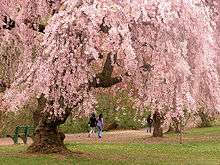
Other US cities have an annual cherry blossom festival (or sakura matsuri), including the International Cherry Blossom Festival in Macon, Georgia, which features over 300,000 cherry trees. The Brooklyn Botanic Garden in New York City also has a large, well-attended festival.[58] Portsmouth, New Hampshire, is the site of the peace conference that produced the Treaty of Portsmouth, for which the original Washington, DC cherry trees were given in thanks. Several cherry trees planted on the bank of the tidal pond next to Portsmouth City Hall were the gift of Portsmouth's Japanese sister city of Nichinan—the hometown of Marquis Komura Jutarō, Japan's representative at the conference.[59] Ohio University in Athens, Ohio, has 200 somei yoshino trees, a gift from its sister institution, Japan's Chubu University.[60]
Culinary use
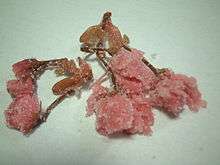
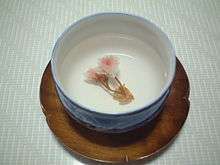
Cherry blossoms and leaves are edible and both are used as food ingredients in Japan:
- The blossoms are pickled in salt and umezu (ume vinegar), and used for coaxing out flavor in wagashi, (a traditional Japanese confectionery,) or anpan, (a Japanese sweet bun, most-commonly filled with red bean paste.)
- Salt-pickled blossoms in hot water are called sakurayu, and drunk at festive events like weddings in place of green tea.
- The leaves, mostly from the Ōshima cherry because of the softness, are also pickled in salted water and used for sakuramochi.
Since the leaves contain coumarin, which is toxic in large doses, it is not recommended to eat them in great quantities.
See also
- Kabazaiku: sakura wood craftsmanship
- Kigo: discussion of the role of sakura in Japanese poetry
- List of Award of Garden Merit flowering cherries
- Ohka: Special Attack Aircraft of World War II
- Subaru Cherry Blossom Festival of Greater Philadelphia
- The Cherry Orchard
References
- ↑ The history and cultural symbolism of both the seven wild species and the hundreds of forms known for centuries as sato-zakura, or garden cherries and information about growing and propagating is found in Kuitert, Wybe (2015-03-06). "Japanese Flowering Cherries". Timber Press.
- ↑ "Sakura". Webster's Third New International Dictionary, Unabridged. Merriam-Webster. 2002. Retrieved 2008-04-02.
JAPANESE FLOWERING CHERRY
- ↑ "Japanese flowering cherry". Webster's Third New International Dictionary, Unabridged. Merriam-Webster. 2002. Retrieved 2008-04-02.
any of certain ornamental hybrid cherries developed in Japan chiefly from two species (Prunus serrulata and P. sieboldii) that bear a profusion of white or pink usually double and often fragrant flowers followed by small inedible fruit...
- ↑ LaGrave, Katherine (2013-04-16). "Cherry Blossoms: History Behind the Bloom". The Huffington Post.
- ↑ "財団法人 日本花の会 - THE FLOWER ASSOCIATION OF JAPAN". hananokai.or.jp.
- ↑ "さくらの基礎知識 - 公益財団法人 日本さくらの会 - JAPAN Cherry Blossom Association". sakuranokai.or.jp.
- ↑ "The beauty and history of sakura, Japan's national flower". Tsunagu Japan. Retrieved 6 January 2016.
|first1=missing|last1=in Authors list (help) - ↑ Brooklyn Botanic Garden (2006). Mizue Sawano: The Art of the Cherry Tree. Brooklyn Botanic Garden. p. 12. ISBN 1-889538-25-6.
- ↑ "Japan's Top 100 Cherry Blossom Spots – GoJapanGo (English language version of list)". Japan's Top 100 Cherry Blossom Spots – GoJapanGo. Mi Marketing Pty Ltd. Retrieved 9 November 2011.
- 1 2 Choy Lee, Khoon. Japan—between Myth and Reality. 1995, page 142.
- ↑ Young, John and Nakajima-Okano, Kimiko. Learn Japanese: New College Text. 1985, page 268.
- 1 2 Slaymaker, Douglas. The Body in Postwar Japanese Fiction. 2004, page 122.
- ↑ James L. McClain, Japan: A Modern History p 414 ISBN 0-393-04156-5
- 1 2 3 4 5 Ohnuki-Tierney, Emiko. Kamikaze, Cherry Blossoms, and Nationalisms. 2002, page 9-10.
- ↑ Piers Brendon, The Dark Valley: A Panorama of the 1930s, p441 ISBN 0-375-40881-9
- ↑ James L. McClain, Japan: A Modern History p 427 ISBN 0-393-04156-5
- ↑ John Toland, The Rising Sun: The Decline and Fall of the Japanese Empire 1936–1945 p 539 Random House New York 1970
- ↑ Meirion and Susie Harries, Soldiers of the Sun: The Rise and Fall of the Imperial Japanese Army p 424 ISBN 0-394-56935-0
- ↑ Sakamoto, Kerri: One Hundred Million Hearts. Vintage Book, 2004. ISBN 0-676-97512-7.
- 1 2 Ivan Morris, The Nobility of Failure: Tragic Heroes in the History of Japan, p290 Holt, Rinehart and Winston, 1975
- ↑ "Cherry Blossom Tattoo Designs". Freetattoodesigns.org. Retrieved 2013-06-14.
- ↑ Origins of Japanese flowering cherry (Prunus subgenus Cerasus) cultivars revealed using nuclear SSR markers
- ↑ "Clone identification in Japanese flowering cherry (Prunus subgenus Cerasus) cultivars using nuclear SSR markers".
- ↑ "サクラ栽培品種の分類体系の再編とデータベース化" (PDF).
- ↑ "桜の新しい系統保全 ―形質・遺伝子・病害研究に基づく取組―" (PDF).
- ↑ "The observation of flowering dates in the Cherry Preservation Forest at the Tama Forest Science Garden over a 30 year period." (PDF).
- ↑ Brandow Samuels, Gayle.
- ↑ "Winter-flowering cherry". Retrieved 1 January 2008.
- ↑ "Festa da Cerejeira em Garça recebe mais de 150 mil visitantes" (in Portuguese). TV TEM. Retrieved 7 July 2015.
- ↑ "Festa da Cerejeira em Flor 2014 celebra a Cultura do Japão em Campos do Jordão" (in Portuguese). Guia de Campos do Jordão. Retrieved 7 July 2015.
- ↑ "Cerejeiras enfeitam cidade no norte do Paraná" (in Portuguese). Jornal Nacional. Retrieved 2011-07-15.
- ↑ "Cerejeiras enfeitam Cascavel" (in Portuguese). Globo Vídeos. Retrieved 2011-07-15.
- 1 2 "Temporada das Cerejeiras em Curitiba" (in Portuguese). Diário Urbano. Retrieved 2011-07-15.
- ↑ "Novo colorido em parques e praças" (in Portuguese). Prefeitura de Curitiba. Retrieved 2011-07-15.
- ↑ "Japan Square". Prefeitura de Curitiba. Retrieved 2011-07-15.
- ↑ "Vancouver Cherry Blossom Festival – VCBF.CA". vcbf.ca. Retrieved 26 April 2010.
- ↑ "Aktuelles aus der Gesellschaft". Deutsch-Japanische Gesellschaft zu Hamburg e.V. Retrieved 2015-04-25.
- ↑ "Cherry Blossoms in Shillong". mapsofindia.com.
- ↑ GRIN. "Prunus cerasoides information from NPGS/GRIN". Taxonomy for Plants. USDA, ARS, National Genetic Resources Program. Retrieved January 24, 2014.
- ↑ Navendu Pāgé. "Cerasus cerasoids – Wild Himalayan Cherry". Flowers of India . Retrieved July 9, 2014. External link in
|publisher=(help) - ↑ "Prunus 'Awanui' (Flowering Cherry)". Moores Valley Nurseries.
- ↑ 가슴과 어깨에 벚꽃을 꽂고 희생 다짐하는 18세 조종사 (in Korean). Joongang. Retrieved 2009-01-03.
- ↑ Ohnuki-Tierney, Emiko. Kamikaze, Cherry Blossoms, and Nationalisms. 2002, page 122-3.
- ↑ Choi Sung-Un (2008). "Biting the cherry: Cherry blossoms and their attendant festivals herald the spring in Korea despite associations with a dark chapter with the country's history". IK-Journal. Investkorea.org. Retrieved 2009-11-30.
- ↑ "[광복 70년•수교 50년 제주와 일본을 말하다/제1부 제주 왕벚의 세계화](3)대량생산 전초기지" [[70 years liberation, 50 years diplomatic relations: Jeju and Japan story / Part 1. Globalization of King cherry of Jeju] (3) Outpost of Mass production]. Halla Ilbo. March 23, 2015.
- ↑ 몰락한 왕조 궁궐에 핀 사쿠라 일제는 갔어도 벚꽃놀이는 남아 (in Korean). 中央日報. Retrieved 2009-05-11.
- ↑ "벚꽃 '한-일 원산지 논쟁' 왜 끝나지 않나" [Cherry "Korea-Japan origin controversy" Why does not end?] (in Korean). Hankyoreh. April 3, 2015.
여의도와 진해를 포함해 우리나라 벚꽃축제의 주인공은 모두 일본이 원예종 으로 만든 왕벚나무이다. [The protagonists of Cherry Blossom Festivals in Korea including Yeouido and Jinhae are all cultivated Yoshino cherry made in Japan.]
- ↑ "Batsford Arboretum". Batsarb.co.uk. Retrieved 2009-11-30.
- ↑ "Keele University Arboretum flowering cherry collection". keele.ac.uk. Retrieved 2011-03-28.
- ↑ "Student scientists track nation's largest collection of cherry blossom trees at Essex County park". The Star-Ledger. August 13, 2010. Retrieved 2012-04-10.
- ↑ Hinds, Kate (March 25, 2012). "Cherry Blossom Trees Flourish in Newark". WNYC. Retrieved 2012-04-10.
- ↑ Drew Anne, Scarantino (March 14, 2011), "In Full Bloom", New Jersey Monthly, retrieved 2012-04-10
- ↑ "nps.gov – Cherry Blossom History". Retrieved 13 January 2009.
- ↑ Jefferson, Roland M. and Alan F. Fusonie. (1977). "The Japanese Flowering Cherry Trees of Washington, D.C.: A Living Symbol of Friendship. National Arboretum Contribution No. 4." Washington: USDA, Agricultural Research Service.
- ↑ "The Nation's Greatest Springtime Celebration". National Cherry Blossom Festival. Retrieved 2013-06-14.
- ↑ Block, Deborah. "Spectacular Cherry Blossoms in Maryland Lure International Visitors". VOA. Retrieved 2016-03-24.
- ↑ rap pr (2006-04-10). "The Big Bloom of Cherry Blossoms at Lake Balboa in Van Nuys". Laparks.blogspot.com. Retrieved 2013-06-14.
- ↑ "BBG.org". BBG.org. 2008-04-26. Retrieved 2013-06-14.
- ↑ Stephanie Seacord. "Cherry trees have historical significance". SeacoastOnline.com. Retrieved 2013-06-14.
- ↑ "Ohio University Outlook". Ohio.edu. Retrieved 2013-06-14.
External links
| Wikimedia Commons has media related to Sakura. |
- Japanese Cherry Blossom Events
- Copenhagen Sakura Festival
- Flowering cherry Database, Forestry and Forest Products Research Institute
- Flowering cherry introduction, Forestry and Forest Products Research Institute
- International Cherry Blossom Festival Online, Information about the 300,000 Yoshino cherry trees in Macon, Georgia and the 10-day celebration held in mid-March
- Vancouver Cherry Blossom Festival, Information about the 37,000 cherry trees in Greater Vancouver (Canada), What's in bloom now, Cherry Scout reports and maps, Cultivar identification.
- Subaru Cherry Blossom Festival of Greater Philadelphia, Information about cherry trees and the annual two-week Subaru Cherry Blossom Festival of Greater Philadelphia.
